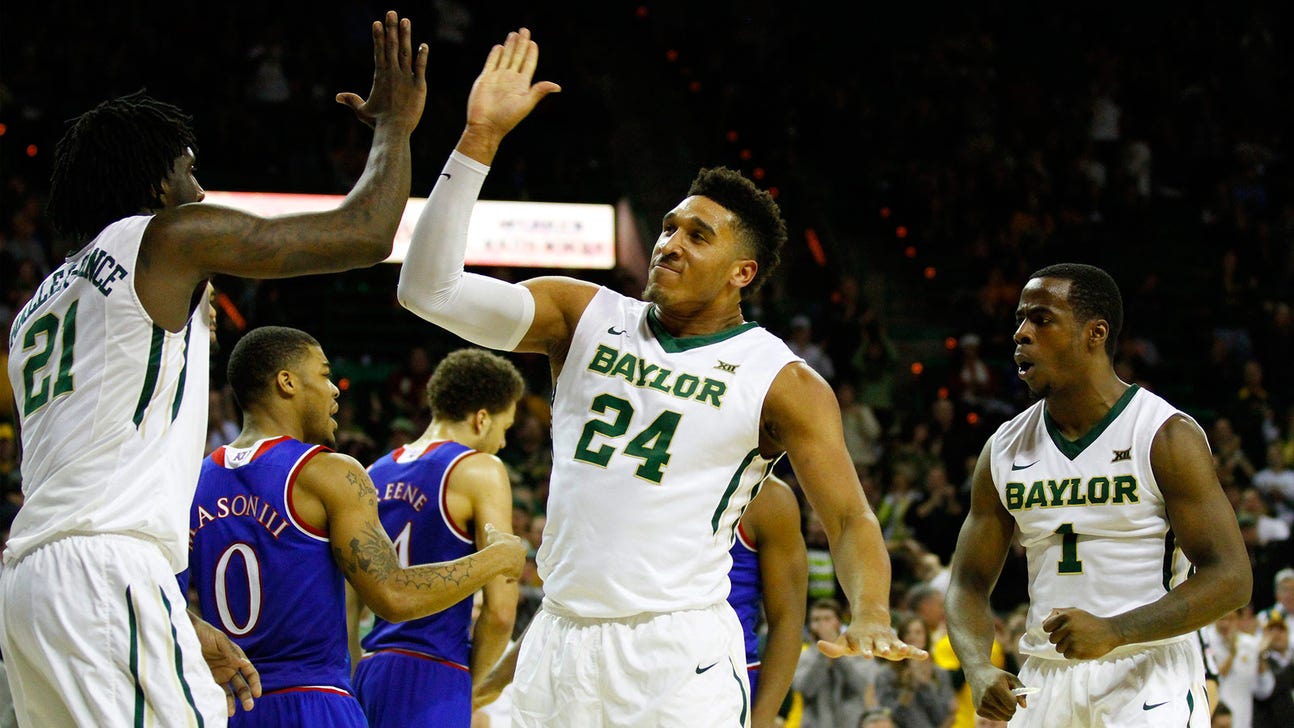
Big 12 March Madness sleepers: West Virginia, Texas and ... Baylor?

KANSAS CITY, Mo. -- There are tons of ways to skin a cat, but only a few that might actually work against Coach Cal's Wildcats. For example: Of the last dozen NCAA Tournament champions dating to 2003, only one -- North Carolina, in 2009 -- did not rank among the top 60 nationally in effective field-goal percentage defense.
And even that's something of a misnomer: The Tar Heels were No. 62 that year, which is close enough.
Bonus: Since 2003, 10 of the 12 champs finished among the top 60 in offensive rebounding percentage. And of those elite dozen, nine of the 12 wound up among the top 60 in both.
So in layman's terms, in Bracketville, if you:
A) get stops; and
B) get second (or third or fourth) looks, more often than not, you dance on.
This year's Kansas Jayhawks: No. 44 in effective field-goal percentage defense (eFG%) and No. 32 in offensive rebounding percentage. Interesting.
And even more interesting when we break down those same parameters on the seven likely dancers from the Big 12 and two from the Missouri Valley:
BIG 12
KU: Opponent eFG percentage: 44th; offensive rebounding percentage: 32nd.
Iowa State: Opponent eFG percentage: 99th; offensive rebounding percentage: 222nd.

Lookin' good! Check out our gallery of Big 12 hoops cheerleaders.
Oklahoma: Opponent eFG percentage: seventh; offensive rebounding percentage: 98th.
West Virginia: Opponent eFG percentage: 261st; offensive rebounding percentage: eighth.
Baylor: Opponent eFG percentage: 25th; offensive rebounding percentage: 1st.
Oklahoma State: Opponent eFG percentage: 39th; offensive rebounding percentage: 288th.
Texas: Opponent eFG percentage: third; offensive rebounding percentage: fourth.
MISSOURI VALLEY
Wichita State: Opponent eFG percentage: 75th; offensive rebounding percentage: 43rd.
Northern Iowa: Opponent eFG percentage: 23rd; offensive rebounding percentage: 288th.
Now numbers are just that: instructive, not absolutes.The Jayhawks have looked very good against a taller Texas team in Austin, escaped by a rat's whisker against Baylor in Waco and got absolutely directional-schooled by Kentucky in November.
But as the NCAA throws its mock selection party later this week in Indianapolis, we like a little instructive along for the ride.
Precedent is fun and generally harmless, as long as you're not the Washington Generals.
At any rate, precedent digs KU (KenPom.com rank: 12 as of early Monday evening) in March, which is to be expected.
Less expected is the fact that it also seems really, really, really warm to Baylor (KenPom: 10), Texas (KenPom: 22), Oklahoma (KenPom: 9), West Virginia (KenPom: 20), Wichita State (KenPom: 15) and UNI (KenPom: 16), too.
So if you're looking for sleepers here in flyover country, look ... well, everywhere.
A little metric back story: Dean Oliver is, for lack of a better parallel, the Bill James of basketball, a "Moneyball" satellite in Dick Vitale's solar system. In his widely quoted book, Basketball On Paper, perhaps the most widely quoted passage is called the Four Factors, four statistics that were most critical in projecting a team's success: effective field-goal percentage (or eFG percentage), turnover percentage, offensive rebounding percentage and free-throw shooting rates (basically, free-throw attempts divided by field-goal attempts).
The blogosphere is littered with treatises on Oliver's factors -- there are eight, technically, if we apply them to both offense and defense -- but ultimately, the four that are the most common among NCAA Final Four teams and, indeed, champions, are effective field-goal percentage, your opponent's effective field-goal percentage, your offensive rebounding percentage and your opponent's offensive rebounding percentage.
In other words, a lot of commonly harped coachspeak is actually right on the money: Teams that survive tend to be the ones that get a lot of stops, either because of a collective effort or a great shot-blocker (or two); ones that score efficiently (effective field-goal percentage weighs the value of a 3-pointer, obviously, as being worth more than a standard shot); ones that get second (and third) shots in a possession; and ones that prevent those kind of chances for the opposition.
To start the week, KU ranks 137th in eFG percentage, 32nd in offensive rebound percentage, 103rd in turnover percentage and 100th in free-throw rate. Defensively, the Jayhawks are 44th in opponent eFG percentage, 163rd in opponent offensive rebounding rate, 301st in opponent turnover rate and 85th in opponent free-throw rate.
Top 60 in Division I: Two categories. Bottom 60: One (opponent turnover rate).
Last winter, different story.
KU was 18th in offensive rebounding percentage, but 75th in opponent eFG percentage -- and that was with the fear/presence of Joel Embiid around for most of the season. The Jayhawks also ranked 181st in fewest opponent 3-point makes, which harkens back to the perimeter issues that drove Self so batty.
And speaking of batty, when we go back to the Big 12 and MVC and break down the number of times a school appears among the top 60 in the critical eight factors (combining offense and defense), the picture muddies a bit:
BIG 12
Iowa State: four times
West Virginia: three times
Baylor: three times
Texas: three times
Oklahoma: two times
Oklahoma State: two times
KU: two times
MISSOURI VALLEY
Northern Iowa: five times
Wichita State: four times
So the Shockers, Panthers, Cyclones, Mountaineers, Bears and Longhorns are solid bets to get out of the first weekend, and maybe the first two, depending on the matchup.
And the Jayhawks? Precedent says KU has the defense and rebounding mojo to win three or four games in the Big Dance. Or they might win none, and out come the pitchforks again.
In other words, same as it ever was.
You can follow Sean Keeler on Twitter at @SeanKeeler or email him at seanmkeeler@gmail.com.